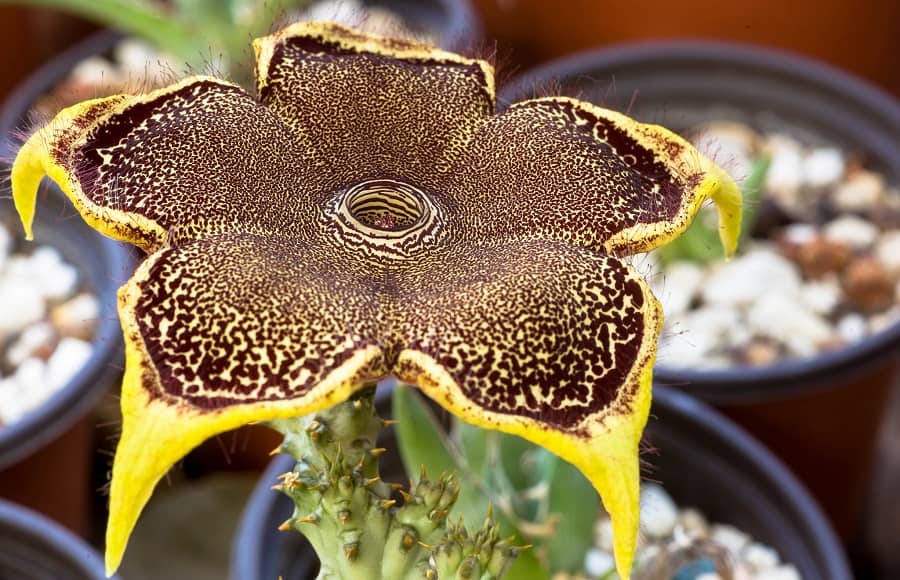Edithcolea Grandis is a succulent with no leaves. The stems have sharp green to red teeth. This plant can measure up to 30 cm long and approximately 4 cm in diameter.
The flowers with hairy margins are approximately 12.5 cm in diameter. The flowers are pale yellow with red-brown spots.
The fruit contains a large number of seeds that you can use to propagate the plant.
Edithcolea grandis Care:
Illumination:
The Edithcolea grandis needs light to stay healthy and alive. I recommend you place it in a planter where it can receive sunlight or near a window.
Watering:
The Edithcolea grandis needs a weekly watering frequency. Depending on the season, you must increase or decrease the irrigation.
In winter, it’s recommended to water it more frequently, at least twice a week. The best way to know that your edithcolea grandis needs water is to put your finger halfway into the ground; if it’s dry, you need to water it.
It is best to water until it begins to overflow at the base of the pot.
You may like: Euphorbia trigona
Temperatures:
It is very susceptible to rot if exposed to temperatures below 5ºC/41°F.
The perfect range for the species is between 22ºC/71°F-30ºC/80°F.
Substrate:
Succulents do not have many substrate needs. It should only be a substrate with good drainage, aeration, and that is loose.
If you do not want to complicate yourself, you can buy a specific substrate for cacti and succulents. Or you can create your own substrate.
You just have to mix a universal substrate or garden soil with vermiculite, river sand, and perlite.
Plagues and diseases:
The main enemies of this plant are the mealybugs that attack the stems, leaves, and roots.
It can also be severely affected by mollusks and ants.
Control pests with specific pesticides to prevent future plant death.
An excess of watering can cause the formation of fungi and the rot of the plant.
Propagation:
This plant can be propagated by cuttings, which is the easiest or by seed, which is a little more complicated.
Seeds
The seeds are sown in pots wider than they are tall, with holes for drainage, filled with substrate.
Then, the seeds are watered and placed on the surface, taking care not to pile them up.
Covered with a thin layer of substrate, or with previously washed river sand, and the seedlings are placed outdoors or in a bright interior near a heat source.
It will begin to issue roots from 15 to 20 days.
Cuttings
It’s the best reliable method to obtain new samples of edithcolea grandis and the simplest.
You must cut a stem with leaves, let the wound dry for approximately 7 days in semi-shade protected from possible rain.
After all this, you can pass the cutting to the pot where you want to plant it, with a specific substrate for cacti and succulents.
Place in a bright location and make sure it avoids direct sunlight, you should also keep the soil moist but without puddles.
Between 15 to 20 days, the plant will begin to emit its first roots.
Fertilizer:
It must be applied throughout the growing season, that is, from spring to the end of summer, it is recommended to use fertilizer for the succulents following the instructions on the package.
You can also add some homemade fertilizer, such as eggshell tea or banana shell tea.
Transplant:
The time of sowing or transplanting should be done in spring when the frosts have passed.
Follow these steps
1. Let the plant out of its current pot. This process will be easier if the pot is plastic.
Otherwise, tap the sides of the pot lightly to loosen the soil and roots from its walls.
I recommended that you use gloves to avoid getting pricked with the thorns.
2. Prepare the new pot; it is vital to have drain holes, if you don’t have them when you buy it, please make them carefully.
Cover the bottom with a bed of thick stones to help keep those holes free and improve drainage, and use substrate for the succulents to enrich it with a slow-release fertilizer.
3. Transplant the succulent, simply place it in its new container, with the green part a couple of centimeters below the edge of the pot, and add the necessary substrate.
If it’s a succulent plant shoot, try to untangle its roots as much as possible, or carefully separate it by gently prying it with a fork.
In the case of children, it is sometimes advisable to wait a few days after separating them from the mother plant to close their possible wounds.
Pruning:
It does not need pruning.
